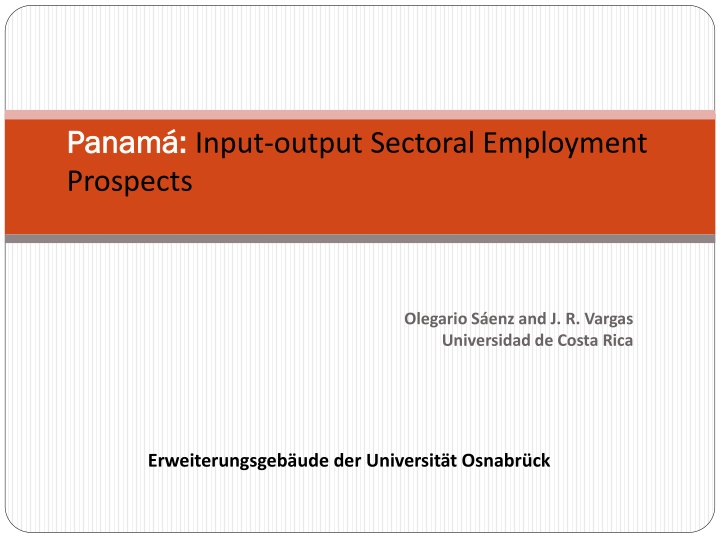
Sectoral Employment Prospects Modeling for Panam 2013-2020
This study focuses on estimating employment generation across various sectors in Panama based on the input-output matrix for the year 2013. The analysis uses assumptions on the evolution of domestic demand components and models endogenous variables like direct employment generation. The results provide insights into short-term employment prospects from 2015 to 2020.
Download Presentation

Please find below an Image/Link to download the presentation.
The content on the website is provided AS IS for your information and personal use only. It may not be sold, licensed, or shared on other websites without obtaining consent from the author. If you encounter any issues during the download, it is possible that the publisher has removed the file from their server.
You are allowed to download the files provided on this website for personal or commercial use, subject to the condition that they are used lawfully. All files are the property of their respective owners.
The content on the website is provided AS IS for your information and personal use only. It may not be sold, licensed, or shared on other websites without obtaining consent from the author.
E N D
Presentation Transcript
Panam: Panam : Input-output Sectoral Employment Prospects Olegario S enz and J. R. Vargas Universidad de Costa Rica Erweiterungsgeb ude der Universit t Osnabr ck
summary The objective is to estimate the employment generation at each sector based on assumptions on the evolution of the components of domestic demand. application The analysis was performed based on a Panamanian input product matrix,developed by the EORA project (2013). This matrix met the technical criteria of multisectoral analysis, but it is not official The endogenous variable is direct employment generation. The results are presented using historical evolution (2011- 2014) as a benchmark. Forecast is done for a short-term horizon (2015-2020). A typical input-output 2
Input-output matrix for Panam Year: 2013; Unit: Millions Balboas; Basic Prices Textiles and Wearing Apparel Mining and Quarrying Food & Beverages Agriculture Fishing . I.C. C G FK INV X DEMAND OUTPUTS Agriculture Fishing Mining and Quarrying Food & Beverages Textiles and Wearing . 166 1 1 6 0 0 419 71 81 818 200 0 0 0 0 0 7 0 2 0 22 199 39 122 580 4,140 7,977 428 47 168 1,923 4,300 42,929 1,246 0 3 5 2 0 4 2 8 6 1 55 17 333 349 22 596 719 116 19 26 39 764 2,642 4,417 63,964 47 15 0 0 273 24 86 1,304 136 18,337 0 1 1 19 5 242 65 162 523 683 16,244 21,035 4,577 11,815 222 LOCAL INPUTS 518 122 203 1,408 1,304 2,539 30,378 21,002 4,638 13,737 408 27,125 66,910 97,288 M 182 1 32 948 3,029 . 22,054 2,306 2 5,014 1,403 30,779 TOTAL IMPUTS 1,246 55 764 2,642 4,417 . 97,288 3
Modeling assumptions The matrix is consistent with the Panama National Accounts for 2013. Exogenous variables are modeled as trends (the totals external to the interrelations matrix. The endogenous variable (employment) is a fixed proportion of the gross value of production, according to the usual input- output practice 4
Modelling scheme MODEL STRUCTURE PRIVATE CONSUMPTION PUBLIC CONSUMPTION INTERNAL DEMAND COEFFICIENT VECTOR INTERNAL DEMAND GDP GROSS CAPITAL FORMATION INVERTORY CHANGE EXPORTS DIRECT EMPLOYMENT COEFFICIENT VECTOR GROSS PRODUCTION VALUE TOTAL SECTORAL EMPLOYMENT EMPLOYMENT PRODUCTIVITY VECTOR 5
Employment and labor force qualifications 6
Activity 2013 73,280 4,013 3,702 27,623 10,844 3,848 9,784 10,065 % Agriculture Fishing Mining and Quarrying Food & Beverages Textiles and Wearing Apparel Wood and Paper Petroleum, Chemical and Non-Metallic Mineral Products Metal Products Electrical and Machinery Transport Equipment Other Manufacturing Recycling Electricity, Gas and Water Construction Maintenance and Repair Wholesale Trade Retail Trade Hotels and Restraurants Transport Post and Telecommunications Finacial Intermediation and Business Activities Public Administration Education, Health and Other Services Private Households Others Re-export & Re-import Total 6.50% 0.40% 0.30% 2.40% 1.00% 0.30% 0.90% 0.90% 0.10% 0.10% 1.10% 12.90% 10.10% 12.00% 0.60% 0.80% 2.60% 6.00% 5.80% 5.20% 1.00% 3.40% 9.40% 6.50% 9.80% 0.00% 100% Employment based on Household surveys and the 2010 Census disaggregation 887 628 12,085 145,729 114,610 135,589 6,230 9,225 29,782 67,897 66,130 59,133 11,362 38,689 106,516 73,791 110,846 0 1,132,289 7 Source Source: : own calculations based on Encuesta de Hogares y el Censo 2010.
Employment by output generating sector (2013) 7% Agriculture 7% Industry Recycling 13% Electricity, Gas and Water Construction 51% 10% Other Services 12% 8
Employment estimation based on qualification methodology Employment estimation based on qualification methodology Based on data from the 2010 Census, employment qualification levels were extrapolated across the 26 branches Qualified workers were defined as those who had at least 4 years of university education Unqualified workers are those who did not finish high school Those who finished secondary education up to the third year of university education were defined as medium qualification. The results are shown on the next chart:
Sectoral Sectoral employment employment by by qualifiction qualifiction High Medium Not Qualified Agriculture Fishing Mining and Quarrying Food & Beverages Textiles and Wearing Apparel Wood and Paper Petroleum, Chemical and Non- Metallic Mineral Products Metal Products Electrical and Machinery Transport Equipment Other Manufacturing Recycling Electricity, Gas and Water Construction Maintenance and Repair Wholesale Trade Retail Trade Hotels and Restraurants Transport Post and Telecommunications Finacial Intermediation and Business Activities Public Administration Education, Health and Other Services Private Households Others Re-export & Re-import 2.8% 7.9% 14.9% 15.9% 13.8% 24.6% 21.6% 11.9% 29.7% 22.3% 11.1% 10.6% 29.5% 12.3% 15.3% 25.7% 16.4% 12.6% 21.4% 39.4% 54.4% 36.1% 59.0% 5.1% 29.6% 0.0% 7.2% 12.5% 22.7% 34.1% 22.2% 36.4% 33.7% 38.8% 39.4% 39.4% 33.1% 21.7% 35.5% 28.3% 38.8% 42.9% 41.0% 38.5% 39.6% 45.7% 37.9% 43.4% 27.6% 21.5% 34.8% 0.0% 89.9% 79.5% 62.4% 50.0% 64.0% 39.0% 44.7% 49.3% 30.9% 38.3% 55.8% 67.6% 35.1% 59.4% 46.0% 31.4% 42.6% 48.9% 39.1% 14.9% 7.7% 20.5% 13.4% 73.4% 35.6% 0.0%
Method to calculate sectoral employment The ILO aproach was used as follows: If Y0 is a exogenous variable, a change on the final demand vector yields a new vector Y1, which in turn will allow for the production vector X1. X1=(I-A)-1Y1 On the base of that new production vector X1, is possible to calculate the direct employment requeriments using the above calculated coefficients.
Graphical Graphical calculation calculation algorithm algorithm MODEL STRUCTURE PRIVATE CONSUMPTION PUBLIC CONSUMPTION INTERNAL DEMAND COEFFICIENT VECTOR INTERNAL DEMAND GDP GROSS CAPITAL FORMATION INVERTORY CHANGE EXPORTS DIRECT EMPLOYMENT COEFFICIENT VECTOR GROSS PRODUCTION VALUE TOTAL SECTORAL EMPLOYMENT EMPLOYMENT PRODUCTIVITY VECTOR 13
Step 1: Gross Value of Production Calculation for 2015-2017 DEMAND Millones Bs OUTPUT GROSS VALUE Millones Bs 2015 455 2016 468 2017 481 2015 1,335 2016 1,377 2017 1,419 1 Agriculture 2 Fishing 3 Mining and Quarrying 4 Food & Beverages Textiles and Wearing Apparel 6 Wood and Paper Petroleum, Chemical and Non-Metallic Mineral Products 1 Agriculture 2 Fishing 3 Mining and Quarrying 4 Food & Beverages Textiles and Wearing Apparel 6 Wood and Paper Petroleum, Chemical and Non-Metallic Mineral Products 50 172 2,063 52 176 2,129 53 179 2,196 58 814 2,838 60 839 2,930 62 863 3,022 5 4,596 241 4,744 248 4,890 255 5 4,721 1,521 4,873 1,573 5,023 1,625 7 11,940 12,322 12,703 7 14,949 15,434 15,918 8 Metal Products 531 547 564 8 Metal Products 2,011 2,080 2,150 9 Electrical and Machinery 5,712 5,917 6,125 9 Electrical and Machinery 7,669 7,944 8,222 10 Transport Equipment 1,493 27,252 1,543 28,146 1,595 29,041 10 Transport Equipment 2,164 38,082 2,238 39,348 2,314 40,618 26 Re-export & Re-import TOTAL 257 72,725 266 75,218 274 77,720 26 Re-export & Re-import TOTAL 257 266 274 105,798 109,429 113,076 Source: Employment Proyection Model
Method to calculate sectoral employment Starting from the gross product , Starting from the gross product , sectoral components are multiplied by the labor components are multiplied by the labor requirements adjusted for productivity requirements adjusted for productivity changes and the employment demand is changes and the employment demand is figured out for each year figured out for each year sectoral
Step 2: Gross Value of Production Calculation for 2015-2017 PRODUCTIVITY CHANGE MATRIX PRIMARY SECONDARY 2.8% 0.4% SECTORAL EMPLOYMENT TERCIARY 4.7% 2015 58.52 72.77 2016 58.25 72.43 2017 57.98 72.09 2015 78,110 4,248 2016 80,196 4,357 2017 82,266 4,464 Agriculture Fishing Agriculture Fishing Mining and Quarrying Food & Beverages Textiles and Wearing Apparel Wood and Paper Petroleum, Chemical and Non-Metallic Mineral Products Metal Products Electrical and Machinery Transport Equipment 4.84 10.45 4.84 10.44 4.83 10.44 Mining and Quarrying Food & Beverages Textiles and Wearing Apparel Wood and Paper Petroleum, Chemical and Non-Metallic Mineral Products Metal Products Electrical and Machinery Transport Equipment 3,941 29,659 4,056 30,601 4,172 31,541 2.45 2.75 2.45 2.74 2.45 2.74 11,585 4,178 11,949 4,318 12,311 4,459 0.70 5.44 0.13 0.32 0.70 5.44 0.13 0.32 0.70 5.43 0.13 0.32 10,483 10,941 970 686 1,071,213 10,817 11,311 1,004 709 1,099,998 11,150 11,685 1,039 732 1,128,463 Re-export & Re-import 0.00 0.00 0.00 Re-export & Re-import MODEL 0 0 0 1,226,015 1,259,317 1,292,283 Source: Employment Proyection Model
Method to calculate sectoral employment The new multiplication by the level of labor The new multiplication by the level of labor force demand (left column) yields the level of force demand (left column) yields the level of specialization (congruent with the one of specialization (congruent with the one of 2013) of the demand for the different types of 2013) of the demand for the different types of labor derived from the final demand vector labor derived from the final demand vector Adding up the column for the ten sectors yields Adding up the column for the ten sectors yields total employment total employment
Step 3: Gross Value of Production Calculation for 2015-2017 EMPLOYMENT ACCORDING QUALIFICATION 2015 1 Agriculture 78,110 High 2,224 Medium 5,656 Not Qualified 70,230 2 Construction 164,802 High 20,218 Medium 46,623 Not Qualified 97,962 3 Wholesale Trade 73,842 High 18,971 Medium 31,702 Not Qualified 23,169 4 Retail Trade 124,008 High 20,379 Medium 50,825 Not Qualified 52,804 5 Hotels and Restraurants 70,976 High 8,931 Medium 27,305 Not Qualified 34,740 QUALIFICATION VECTOR Agriculture 2016 80,196 2,284 5,807 72,105 170,563 20,925 48,252 101,386 75,891 19,497 32,582 23,812 127,398 20,936 52,214 54,247 72,806 9,162 28,009 35,636 2017 82,266 2,342 5,957 73,967 176,380 21,638 49,898 104,844 77,928 20,021 33,456 24,451 130,728 21,484 53,579 55,665 74,594 9,387 28,697 36,511 High Medium Not Qualified 2.8% 7.2% 89.9% Construction High Medium Not Qualified Wholesale Trade 12.3% 28.3% 59.4% High Medium Not Qualified 25.7% 42.9% 31.4% Retail Trade High Medium Not Qualified Hotels and Restraurants 16.4% 41.0% 42.6% High Medium Not Qualified 12.6% 38.5% 48.9% Source: Employment Proyection Model
Benchmarking: Comparing model results with those of the National Household Survey, 2012-2015 The black bars are the historical base, the grey ones are the model results
GDP GDP growth growth assumptions assumptions 7.0% 6.5% 6.3% 6.1% 6.0% 6.0% 6.0% 5.9% 5.8% 5.7% 5.7% 5.5% 5.5% 5.5% 5.4% 5.2% 5.2% 5.1% 5.0% 4.8% 4.8% 4.7% 4.5% 4.5% 4.5% 4.0% 2014 2015 2016 2017 2018 2019 2020 OPTIMISTA BASE PESIMISTA The paths are what it seemed reasonable based on recent performance
Base, Base, pessimistic pessimistic and and optimistic optimistic scenarios scenarios: : 2015 2015- -2020 2020 Sector Base Pessimistic Optimistic Agriculture Construction Wholesale Trade Retail Trade Hotels and Restraurants Transport Public Administration Education, Health and Other Services Private Households Others Average 2.70% 3.60% 2.80% 2.70% 2.60% 2.50% 2.40% 2.40% 2.60% 2.40% 2.70% 2.30% 3.00% 2.30% 2.30% 2.10% 2.00% 2.00% 1.90% 2.10% 2.00% 2.30% 3.00% 4.00% 3.20% 3.10% 2.90% 2.80% 2.70% 2.70% 2.90% 2.70% 3.10% Agriculture, construction, wholesale, retail, hosting, transport, government, services, houselds and others
Sectoral Sectoral employment employment growth growth results results Agricultura 14,000 12,000 10,000 Agriculture 8,000 11,628 10,399 6,000 8,721 4,000 2,000 0 Optimista Base Pesimista Alta Media No Calificada Construcci n 40,000 35,000 30,000 22,411 25,000 19,840 Construction 20,000 16,374 15,000 10,000 5,000 0 Optimista Base Pesimista Alta Media No Calificada
Sectoral employment growth results Administraci n P blica 20,000 18,000 16,000 14,000 12,000 Public administration 7,712 10,000 6,797 8,000 5,557 6,000 4,000 6,415 5,654 4,623 2,000 0 Optimista Base Pesimista Alta Media No Calificada Educaci n, Salud y Otros Servicios 25,000 20,000 15,000 Education, Health and other services 10,000 12,776 11,310 5,000 9,305 0 Optimista Base Pesimista Alta Media No Calificada
Rasmussen Sectoral Classification Classification Key sectors have high backward and forward linkages, being strong demanders and suppliers of intermediate inputs. They are sectors of forced passage of intersectoral flows. Provider sectors have low demand for inputs, but they supply many inputs to other sectors. They could mean production bottlenecks, as opposed to demand shocks. Dragging sectors have high backward demand, but low forward sales. They have high intermediate consumption and they are mostly suppliers to the final demand groupings. Independent sectors are relatively isolated. They consume a small amount of intermediate inputs and allocate their production to final demand groupings. Canal Zone and Standard Fruit are obvious examples. They are the most frequency cases.
Empirical Rasmussen Sectoral Classification Classification INDEPENDENT PROVIDER DRAG KEY Textiles and Wearing Apparel Electricity, Gas and Water Agriculture Fishing Food & Beverages Mining and Quarrying Transport Equipment Wood and Paper Petroleum, Chemical and Non-Metallic Construction Other Manufacturing Metal Products Maintenance and Repair Electrical and Machinery Recycling Retail Trade Wholesale Trade Hotels and Restraurants Transport Post and Telecommunications Finacial Intermediation and Business Activities Public Administration Education, Health and Other Services Private Households Others Re-export & Re-import
COSTA RICA AND PANAMA: Empirical Rasmussen Sectoral Classification Classification CR-DRAG PAN-DRAG CR-INDEPENDENT PAN-INDEPENDET Textiles and Wearing Apparel Food & Beverages Fishing Textiles Wood and Paper Hotels and Restraurants Transport Equipment Electricity Electricity, Gas and Water Post and Telecommunications Investment Activities Other Manufacturing Water Supply Construction Recycling Maintenance and Repair Information Activities Insurance Activities Public Administration Maintenance and Repair Retail Trade Hotels and Restraurants Public Administration Education, Health and Other Services Private Households Others Re-export & Re-import Education Health CR-KEY PAN-KEY CR-PROVIDER Industry Transport PAN-PROVIDER Agriculture Mining and Quarrying Petroleum, Chemical and Non-Metallic Mineral Products Electrical and Machinery Wholesale Trade Transport Post and Telecommunications Finacial Intermediation and Business Activities Agriculture Other Industry Food & Beverages Wood and Paper Finacial Intermediation and Business Activities Construction Metal Products Trade Other Services Inmobiliary Activities Private Services
Rasmussen Sectoral Classification Classification and Employment 2%4% 71% of employment is in the INDEPENDIENT sectors, 23% in PROVIDERS, 4% in DRAGGING and 2% in KEY sectors. 23% KEY DRAG PROVIDER INDEPENDENT 71%
Rasmussen Sectoral Classification COSTA RICA VS PANAMA Classification and Employment PANAMA: 71% of employment is in the INDEPENDIENT sectors, 23% in PROVIDERS, 4% in DRAGGING and 2% in KEY sectors. COSTA RICA: 53% of employment is in the KEY sectors, 19% in PROVIDERS, 18% in INDEPENDIENT and 9% in DRAG sectors 100% 90% 19% 23% 80% 4% 70% PROVIDER 60% 53% KEY 50% INDEPENDENT 40% 71% DRAG 30% 20% 18% 10% 9% 2% 0% COSTA RICA PANAMA
Thank Thank you patience patience and you for and attention attention for your your The Costa Rican results are available but it seemed better not to present them today















